Nobeyama Astronomers Find a Proto-quasar - a Young Super-massive Black Hole - in a Dark Monster Galaxy
| Science
An international team led by astronomers at the NAOJ Nobeyama has discovered a candidate for a proto-quasar 11.5 billion light-years away from the Earth. Quasars are the most luminous nuclei of galaxies in the Universe, and are believed to be powered by gravitational energy of super-massive black holes residing at the centers of galaxies. There is a longstanding prediction that quasars form when galaxies clash into each other, which can feed a huge amount of gaseous fuel to the central black holes. The important step to test this hypothesis is to find observational signatures of a baby quasar, called a “proto-quasar”. But proto-quasars are expected to be covered by a dark cocoon of dust and gas, which could be troublesome for astronomers to observationally confirm their existence.
The team used several telescopes including a submillimeter telescope ASTE, the Subaru telescope, and the Submillimeter Array in the U.S. to investigate a monster galaxy that the team already found in a overcrowded region of galaxies, where galaxy collisions are expected to occur very often. They found compelling evidence for the existence of a proto-quasar from their observations in the submillimeter-wave and X-ray, which penetrate even thick gas clouds. In contrast, the heart of the galaxy is unseen in visible light, likely because the monster galaxy is completely enshrouded by a dark nebula. Surprisingly, the total amount of energy emitted by the X-ray object reaches two trillion times of that from the Sun, and the only phenomenon which can naturally explain the origin of the energy is a rapid growth of a massive black hole at the heart of the monster galaxy. This object will offer a special ‘laboratory’ for astronomers to investigate how super-massive black holes are growing up.
